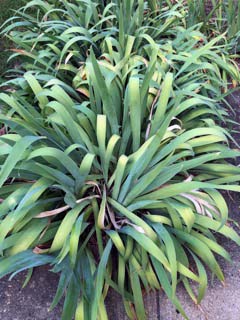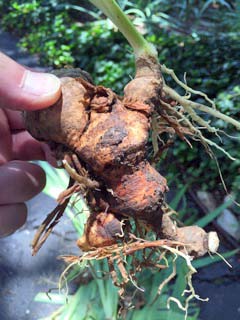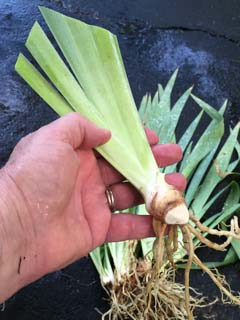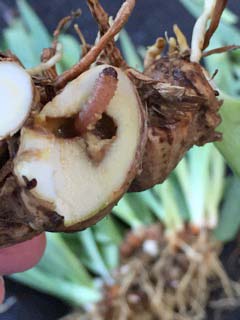Divide Irises for Better, More Abundant Blooms
by Doug Coffey, former Fairfax Master Gardener

Overgrown iris bed
Bearded irises (Iris germanica) can provide your garden with an amazing palette of color from early spring through late spring. Some will even rebloom in the fall. But what do you do when that profusion of color starts thinning out?
If your irises haven’t been putting up blooms the way they once did, it may mean they are overcrowded and require division. The good news is that August is the perfect time to tackle that task.
If your clump of irises is in a sunny location, receiving at least six hours of sun, you may only need to cut out the dead rhizomes in the center of clump. New bloom stalks will not grow from dead rhizomes. Removing the dead material in the center will allow new division growth to expand back into that area.
It is time to divide when:
- Your irises are growing in an area that has become too shady.
- The clump is overcrowded and bigger than you had intended it to be.
The tools you will require for this project are a spading fork, a sharp knife, a pair of garden scissors and a water hose with a nozzle.
Begin with the spading fork. Work your way around the iris clump to loosen the soil and dig up the entire clump. Shake off any loose dirt, and then spray the clump with water from your hose to remove all the soil. Carefully pull apart the entangled root and rhizomes into separate individual plants, and wash these clean.

Cut out and throw away overgrown clump

Now it’s time to get out your knife. Use the knife to cut away all of the soft and dead tissue from the rhizome. Because irises will only put up bloom stalks on new divisions, there can be quite a bit of rhizome tissue to cut away in an old clump. Use the scissors to trim the leaf fan into an inverted V-shape and the roots to about fist length.
Do not mulch iris leaves and dead rhizomes. I recommend you save only the best plants with healthy root systems and at least three leaf fronds on the rhizome.
After all the cleaning and trimming, soak each plant in a 10-percent Clorox solution for about three minutes to kill any bacteria that may be lingering on the plant. Then rinse the plant thoroughly with water and allow to air dry.
This is where you can become a good neighbor and share your plant increases. Throw away the remaining dead rhizome and leaf trimmings. Do not compost them.
You can replant immediately, or if you want to move your irises to a new location, aim to get them into the ground within two weeks. If your replanting is delayed, soak the plant in a water bath for several minutes before planting. Enjoy that beautiful iris bloom again.
If left unattended, iris beds become overcrowded as new plants compete for nutrients. The result is smaller new divisions and fewer bloom stalks. The entire clump becomes a breeding ground for disease and pests. One of the keys to maintaining a healthy bearded-iris bed is true of most perennial plantings. Keep the bed clean.

Clean, trimmed, healthy rhizome
After blooming season, sanitation is important. Snap off the bloom stalks at the top of the rhizome. Then, each fall, clean out all the dead leaves and weeds. Throw away the leaves and stalks. Do not compost them.
The debris, if left in place, becomes a breeding place for iris borer caterpillars (Macronoctua onusta), the most destructive insect pest your iris will encounter. The caterpillar tunnels through the leaves, reaching the rhizome by mid-summer and growing to about 2 inches long. Iris borers do severe damage to iris by consuming the rhizome.
The iris borer’s feeding can lead to another danger: bacterial soft rot. Rhizomes infected by soft rot are slimy, soft and foul-smelling.

Iris borer
The rot will eventually kill the plant if not treated. If you find evidence of soft rot, scrape away the rot to hard, healthy flesh, and sprinkle the area with a kitchen cleaner such as Comet.
By attending to some simple “housekeeping” tasks, you will go a long way towards ensuring a healthy iris bed with an abundance of lovely blooms.
Resources
Iris germanica, Missouri Botanical Garden
Dividing Iris, Laura Spencer, Penn State Extension
…updated 2023